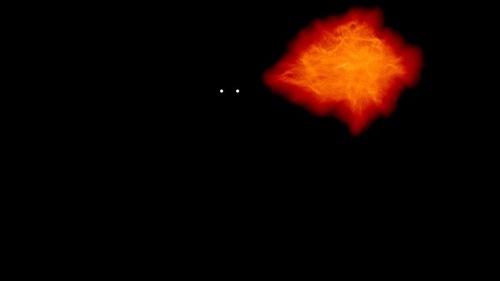
Scientists have discovered that artificial light can disrupt the ability of many insects to orient themselves relative to the sky. Motion-capture videos of moths and other insects indicate that they instinctively position themselves so that their backs face the light source, causing them to fly in erratic patterns near artificial light.
Turn on a light outside at night, and it won’t be long before a bevy of insects start careening wildly around it. Now, in a series of studies, scientists say that insects do this because the artificial light can confuse their natural sense of direction while flying. This behavior makes sense in a natural, dark setting such as a forest where the starry sky is usually the brightest source of light, providing a reference to help insects reorient themselves quickly. However, when the brightest light comes from a light bulb, the insects’ attempt to keep their backs tilted towards the brightness leads to disoriented flight patterns, as seen around porch lights.
Previous theories about the reasons behind insects’ attraction to light, ranging from blindness caused by light, confusion with the moon’s navigation, and using light as an escape route, had never been definitively tested. However, a high school trip to a remote wildlife sanctuary sparked Yash Sondhi’s curiosity about why moths are drawn to light, leading to further research and collaboration with Sam Fabian to investigate this phenomenon.
Fabian, who had developed a method to track dragonflies’ flight using motion capture technology, joined forces with Sondhi to conduct experiments with moths. The researchers used specialized cameras to study insects’ behavior in response to artificial light in both laboratory and field settings, revealing that the insects tried to keep their backs towards the light, resulting in erratic flight patterns that rendered them unable to leave the area. This unusual behavior led the scientists to consider how artificial light might be affecting insects and explore potential solutions to mitigate these effects.
The researchers discovered that creating a light source that resembles the sky, such as a diffuse, reflected light displayed on a high sheet in the forest, allowed insects to fly under it without becoming disoriented. This finding suggested that insects are not inherently attracted to the light itself, but rather use it to orient themselves. The study also noted that some species, such as the Oleander Hawkmoths and fruit flies, did not exhibit the same disoriented flight behavior, raising questions about why these species react differently to artificial light.
While some entomologists find the results convincing, questions remain about the evolutionary reasons behind insects’ response to light. Brett Seymoure, a researcher studying the impact of light on animals, acknowledges the significance of the findings but highlights the need to explore the evolutionary implications of insects orienting themselves towards light.
Moreover, the study raises concerns about the potential impact of artificial light on insect populations and emphasizes the need for further research to understand how insects are affected by artificial light from a conservation perspective. The study’s observations suggest that insects may struggle more when faced with lights pointing upwards, leading to potential negative consequences for insect populations. As a result, the study suggests that minimizing lights pointing upwards could help mitigate the impact on insects.













